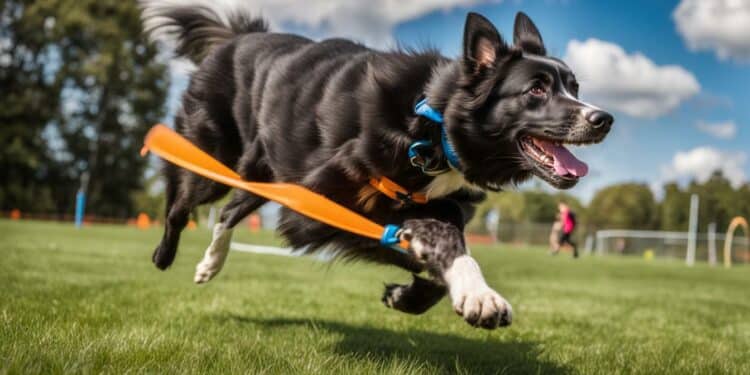Ultimate Guide to Canine Fitness: Tips for Keeping Your Dog in Top Shape

Welcome to the ultimate guide on canine fitness, where you’ll discover valuable tips and techniques for ensuring your dog stays in peak physical condition. As a responsible dog owner, it is crucial to prioritize your dog’s health and well-being. This comprehensive guide will provide you with insights into various aspects of canine fitness, including exercise, nutrition, grooming, vet check-ups, mental stimulation, and more. By implementing these tips, you can ensure that your furry friend leads a happy, healthy, and active lifestyle.
Regular exercise is the cornerstone of maintaining your dog’s overall health. Just like humans, dogs need physical activity to stay fit and prevent various health issues. In this guide, you’ll learn about the importance of regular exercise and practical ways to incorporate it into your dog’s routine. Whether it’s brisk walks, fun games, or engaging in canine sports like agility, we have tips tailored to suit your dog’s needs and energy levels.
A balanced diet is another essential factor in keeping your dog in top shape. Proper nutrition promotes optimal fitness and overall well-being. We’ll delve into the importance of a balanced diet, offer guidance on choosing the right food for your dog’s specific needs, and provide tips on weight loss for overweight dogs.
Grooming plays a crucial role in maintaining your dog’s health and wellness. Regular grooming sessions not only contribute to a healthy coat but also aid in preventing external parasites. We’ll provide you with expert techniques and insights on proper grooming practices, ensuring that your dog’s fur remains clean, healthy, and free from potential health risks.
Regular vet check-ups are a must for every dog. These visits are essential for monitoring your dog’s overall health and detecting any potential issues early on. In this guide, we’ll highlight why vet check-ups are crucial, especially for puppies, middle-aged dogs, and seniors, and provide tips on making the most out of these visits.
Mental stimulation is often overlooked but is vital for your dog’s overall well-being. Engaging your dog’s mind is just as important as keeping them physically active. We’ll explore various activities and games that can challenge your dog’s intelligence, providing mental stimulation and preventing boredom.
“The Workout Book for Dogs” is a valuable resource mentioned in this guide, offering practical exercises tailored to improve your dog’s strength, relaxation, flexibility, coordination, and tactile awareness. Incorporating these exercises into your dog’s fitness routine can yield tremendous benefits and contribute to their overall fitness and well-being.
Furthermore, we’ll guide you on monitoring and measuring your dog’s fitness progress. By tracking their weight, body condition, and overall health, you can set achievable goals and ensure steady improvement in your dog’s fitness journey.
Lastly, we’ll discuss the importance of tailoring exercise routines based on different dog breeds. Different breeds have varying exercise needs, and understanding these requirements will help you create a customized fitness plan that suits your dog’s breed and age.
In conclusion, this ultimate guide serves as your go-to resource for canine fitness tips. By following the advice and techniques provided, you can ensure that your dog remains in top shape, leading a healthy and active lifestyle. So let’s begin this journey together and discover how you can maximize your dog’s fitness potential.
The Importance of Regular Exercise
Regular exercise is vital for keeping your dog healthy and happy. Just like humans, dogs need physical activity to maintain optimal fitness levels and prevent health issues. A sedentary lifestyle can lead to obesity, muscle atrophy, and behavioral problems in dogs. By incorporating regular exercise into your dog’s routine, you can ensure they stay in top shape and enjoy a higher quality of life.
Physical activity is not only good for your dog’s physical well-being but also their mental and emotional health. Exercise helps release excess energy, reduces stress and anxiety, and promotes mental stimulation. It can also strengthen the bond between you and your furry friend, as you can engage in activities together, such as walking, running, or playing fetch.
When planning exercise for your dog, it’s important to consider their age, breed, and overall health. Different dog breeds have varying exercise needs, with some requiring more intense workouts than others. For example, high-energy breeds like Border Collies or Huskies may benefit from activities such as agility training or running, while smaller breeds or senior dogs may prefer shorter walks or gentle play sessions.
The Benefits of Regular Exercise for Dogs:
- Weight management and prevention of obesity
- Improved cardiovascular health and endurance
- Stronger muscles and better joint flexibility
- Enhanced mental stimulation and reduced behavioral problems
- Increased socialization opportunities with other dogs and humans
Remember to consult with your veterinarian before starting any new exercise regimen for your dog, especially if they have pre-existing health conditions. Your vet can provide guidance on the appropriate duration and intensity of exercise for your furry companion.
| Exercise Type | Duration | Frequency |
|---|---|---|
| Brisk Walk | 30 minutes | 5 times a week |
| Play Fetch | 15 minutes | Daily |
| Agility Training | 20-30 minutes | 3 times a week |
| Swimming | 20-30 minutes | 2 times a week |
Regular exercise is key to maintaining your dog’s physical and mental well-being. It provides numerous benefits, from weight management to improved cardiovascular health. Remember to tailor the exercise routine to your dog’s specific needs and consult with your veterinarian for guidance. By keeping your dog active, you’re ensuring they have a happier and healthier life.
A Balanced Diet for Optimal Fitness
Feeding your dog a balanced diet is crucial for maintaining their optimal fitness level. Just like humans, dogs require a well-rounded nutrition plan to support their overall health and well-being. By providing the right combination of nutrients, you can fuel your dog’s energy levels, promote a healthy weight, and ensure their body functions at its best.
When it comes to selecting the right food for your dog, it’s important to consider their age, size, breed, and any specific dietary needs they may have. Consulting with a veterinarian can provide valuable guidance and help you choose a diet that meets your dog’s unique requirements.
A balanced diet includes a combination of high-quality proteins, healthy fats, carbohydrates, vitamins, and minerals. Look for dog food options that have real meat as the main ingredient, as this provides essential amino acids for muscle development and repair. Whole grains and vegetables are excellent sources of carbohydrates and fiber, while fruits can offer additional vitamins and antioxidants.
The Importance of Weight Management
Weight management is an integral part of maintaining your dog’s optimal fitness level. Just like humans, obesity in dogs can lead to a range of health complications, including joint problems, heart disease, and diabetes. It’s essential to monitor your dog’s weight and adjust their diet accordingly to prevent excessive weight gain or loss.
If your dog needs to lose weight, it’s important to do so gradually and under the guidance of a veterinarian. Crash diets can be harmful and result in nutrient deficiencies. Instead, focus on portion control, reducing calorie intake, and incorporating regular exercise into their routine. A weight loss plan tailored to your dog’s specific needs will ensure they shed pounds safely and effectively.
A healthy diet is the foundation of optimal fitness for your dog. By providing a well-balanced nutrition plan and managing their weight, you can help them achieve and maintain their best health and fitness levels.
| Nutrient | Sources |
|---|---|
| Protein | Real meat, fish, eggs |
| Carbohydrates | Whole grains, fruits, vegetables |
| Fats | Healthy oils, such as fish oil or flaxseed oil |
| Vitamins | Fruits, vegetables, nutritional supplements |
| Minerals | Meat, grains, fruits, vegetables |
The Power of Canine Sports
Canine sports provide a fun and effective way to boost your dog’s fitness levels and enhance their overall well-being. Whether it’s agility, flyball, or obedience training, these activities offer unique physical and mental challenges that can help keep your furry friend in top shape.
Agility is one of the most popular canine sports, where dogs navigate through obstacle courses with speed and precision. This high-energy activity requires quick thinking and coordination, improving your dog’s flexibility and balance. It also provides a great cardiovascular workout, helping to strengthen their heart and lungs.
| Sport | Description |
|---|---|
| Agility | A high-energy sport where dogs navigate obstacle courses |
| Flyball | A relay race where dogs jump over hurdles to retrieve a ball |
| Obedience Training | A disciplined sport that focuses on commands and obedience |
Agility is like a dance between you and your dog. It requires trust, communication, and teamwork. The bond you build during training and competitions is truly special.
Flyball is another exciting sport that combines speed, agility, and teamwork. Dogs race over a series of hurdles, retrieving a ball from a box and returning it to their handlers. This fast-paced sport not only improves your dog’s speed and agility but also enhances their focus and impulse control.
In addition to agility and flyball, obedience training is a valuable sport that provides mental stimulation and strengthens the bond between you and your dog. This disciplined activity focuses on commands and obedience, teaching your dog to follow instructions and respond to your cues.
Benefits of Canine Sports
- Improves physical fitness through cardiovascular exercise and strength training
- Enhances mental stimulation and problem-solving abilities
- Promotes socialization with other dogs and handlers
- Strengthens the bond between you and your four-legged companion
- Boosts confidence and self-esteem in both dogs and owners
Whether your dog is a natural athlete or just starting their fitness journey, canine sports offer a wide range of benefits. So, lace up your running shoes, grab a leash, and get ready to unleash your dog’s full potential!
Grooming for Health and Wellness
Keeping your dog groomed is not just about looking good but also plays a crucial role in maintaining their overall health and wellness. Regular grooming sessions can help keep your dog’s skin and coat healthy, prevent matting, and spot any external parasites or skin issues early on.
During grooming, it’s important to pay attention to your dog’s ears, paws, and nails. Cleaning your dog’s ears regularly can help prevent infections, while trimming their nails keeps them at a healthy length and reduces the risk of discomfort or injury. Additionally, regular brushing and bathing help remove dead hair and dirt, promote healthy circulation, and keep your dog’s coat shiny and free from tangles.
Grooming Tips:
- Brush your dog’s coat regularly, especially if they have long hair, to prevent matting and remove loose hair.
- Clean your dog’s ears using a veterinarian-recommended ear cleaning solution and avoid using cotton swabs, which can push debris further into the ear canal.
- Trim your dog’s nails regularly, taking care not to cut them too short to avoid causing pain or bleeding. If you’re unsure, consult a professional groomer or veterinarian for assistance.
- Bathe your dog with a gentle dog shampoo, taking into consideration their specific needs and any skin conditions they may have. Avoid using human shampoos, as they can be too harsh for your dog’s skin.
| Grooming Benefits: | Grooming Frequency: |
|---|---|
| Healthy skin and coat | Regular brushing |
| Early detection of skin issues or external parasites | As needed |
| Prevention of matting and tangling | Regular brushing and grooming |
| Proper ear hygiene and prevention of infections | Cleaning as needed |
| Comfortable nail length and reduced risk of injury | Regular nail trimming |
Remember, grooming your dog not only keeps them looking their best but also contributes to their overall health and well-being. Regular grooming sessions provide an opportunity to bond with your pet while ensuring they stay comfortable and happy. If you’re unsure about any aspect of grooming, don’t hesitate to seek guidance from a professional groomer or veterinarian.
Veterinarian Check-Ups: A Must for Every Dog
Regular vet check-ups are a fundamental part of ensuring your dog’s overall health and well-being. Just like humans, dogs require preventive care and monitoring to detect any potential health issues early on. By scheduling regular visits to your veterinarian, you can provide your furry friend with the best possible care and take proactive measures to keep them healthy.
During these check-ups, your veterinarian will conduct a thorough examination of your dog, assessing their physical condition, vital signs, and overall health. They may also perform tests, such as bloodwork or urine analysis, to gain further insights into your dog’s well-being. These routine screenings can help identify potential health concerns, such as infections, organ dysfunction, or early signs of disease.
In addition to the physical examination and tests, your vet can provide valuable guidance on various aspects of your dog’s health. They can advise you on proper nutrition, including selecting the right diet for your dog’s age, breed, and specific needs. They can also address any behavioral concerns and offer solutions to keep your dog mentally stimulated and happy.
Remember, regular vet check-ups are especially crucial for puppies, middle-aged dogs, and senior dogs. Puppies require vaccinations and deworming treatments to ensure their immune systems develop properly. Middle-aged and senior dogs may require additional screenings and tests to monitor common age-related issues like arthritis, dental problems, or weight management. By staying proactive and maintaining a close relationship with your veterinarian, you can provide your furry companion with the best possible care throughout their life.
| Benefits of Regular Vet Check-Ups: |
|---|
| Early detection of potential health issues |
| Prevention and management of diseases |
| Professional guidance on nutrition and behavior |
| Monitoring and managing weight and age-related conditions |
| Ensuring your dog’s vaccinations and preventive treatments are up to date |
Canine Mental Stimulation: Keeping Their Minds Fit
Just like physical exercise, mental stimulation is crucial for keeping your dog fit and happy. Engaging their minds through various activities and games not only helps prevent boredom, but also enhances their overall well-being. Here are some effective ways to provide mental stimulation for your furry friend:
- Puzzle toys: These interactive toys challenge your dog’s problem-solving skills and keep them mentally stimulated. Fill them with treats or kibble to encourage active engagement.
- Scent work: Dogs have an incredible sense of smell, and engaging in scent work activities taps into their natural instincts. Hide treats or toys around the house or backyard for them to find.
- Training sessions: Teach your dog new tricks and commands to keep their minds sharp. Training not only provides mental stimulation but also strengthens the bond between you and your dog.
- Playdates: Social interaction with other dogs provides mental stimulation and allows for the development of social skills. Arrange playdates with friendly dogs in your area.
Remember that mental stimulation should be tailored to your dog’s individual needs and preferences. Some dogs may enjoy activities like agility training or flyball, which require mental focus and physical exertion. Others may prefer quieter activities such as puzzle-solving or sniffing games. Observe your dog’s reactions and adapt the stimulation accordingly.
Why Mental Stimulation Matters
Mental stimulation is just as important as physical exercise for your dog’s overall well-being. It helps prevent behavioral issues such as excessive barking, destructive chewing, and anxiety. Dogs that are mentally stimulated are happier, more content, and less prone to developing behavioral problems.
By incorporating mental stimulation into your dog’s daily routine, you can provide them with the mental challenges they crave. A mentally stimulated dog is a healthy and balanced dog, ready to face the world with confidence and enthusiasm.
| Benefits of Mental Stimulation | Activities to Try |
|---|---|
| Prevents boredom and destructive behavior | Puzzle toys, scent work, training sessions |
| Enhances problem-solving skills | Puzzle toys, training sessions |
| Reduces anxiety and stress | Socialization, training sessions |
| Strengthens the bond between you and your dog | Training sessions, playdates |
The Workout Book for Dogs: Practical Exercises for Fitness
“The Workout Book for Dogs” is a must-have guide that offers a wide range of exercises to enhance your dog’s fitness and overall well-being. Whether you have an energetic breed that needs a lot of exercise or a more laid-back companion, this book has something for every dog. It provides easy-to-follow instructions, detailed illustrations, and helpful tips to ensure that both you and your furry friend stay motivated and engaged.
The exercises in this book are designed to target different areas of your dog’s fitness, including strength, relaxation, flexibility, coordination, and tactile awareness. From basic movements like sit-ups and push-ups to more advanced exercises such as balance work and obstacle courses, there is a variety of options to suit your dog’s individual needs and abilities.
To make it even more convenient for you, the book includes a complete table with suggested exercise routines based on your dog’s age, breed, and fitness level. This allows you to create a customized workout plan that ensures a balanced approach to your dog’s fitness journey.
Sample Exercise Routine:
| Exercise | Repetitions | Duration |
|---|---|---|
| Sit-Ups | 3 sets of 10 | 5 minutes |
| Balance Board | 3 sets of 1 minute | 10 minutes |
| Obstacle Course | 1 run-through | 15 minutes |
Remember, consistency is key when it comes to your dog’s fitness routine. Aim for regular exercise sessions, gradually increasing the intensity and duration as your dog becomes more comfortable and fit. And don’t forget to have fun along the way! Bonding with your furry friend through exercise will not only benefit their physical health but also strengthen your relationship.
Monitoring and Measuring Your Dog’s Progress
Keeping track of your dog’s fitness progress is essential for ensuring their continued well-being. Regular monitoring allows you to assess their overall health, identify any changes or concerns, and make necessary adjustments to their exercise and diet regimen.
One effective way to track your dog’s progress is by maintaining a fitness journal. This can include details such as the types of exercises or activities they engage in, the duration and intensity of each session, and any observations or notes regarding their performance. By recording this information regularly, you can easily identify patterns, improvements, or areas that may require additional attention.
Another important aspect of monitoring your dog’s progress is by measuring their physical attributes. This can involve keeping track of their weight, body condition, and muscle tone. Regularly measuring these factors allows you to ensure that your dog is maintaining a healthy body composition and not becoming overweight or underweight.
| Physical Attribute | Measurement Tips |
|---|---|
| Weight | Weigh your dog using a scale specifically designed for pets. Aim for consistency by weighing them at the same time of day on a weekly or monthly basis. |
| Body Condition | Use a body condition scoring system to assess your dog’s body composition. Pay attention to their waistline, ribs, and overall muscle tone. |
| Muscle Tone | Regularly feel your dog’s muscles to assess their tone and development. Look for signs of increased muscle mass and strength. |
Additionally, it’s important to observe your dog’s behavior and energy levels. Are they showing signs of increased stamina, endurance, or enthusiasm during physical activities? Do they appear more alert and engaged in mental stimulation exercises? These behavioral indicators can be valuable in gauging the progress of your dog’s fitness journey.
Tailored Exercise for Different Dog Breeds
Understanding the exercise needs of your dog’s breed is key to designing an exercise routine that meets their unique fitness requirements. Different breeds have varying energy levels and physical capabilities, which means their exercise regimens should be tailored accordingly.
Large, high-energy breeds like German Shepherds and Labrador Retrievers require more intense workouts to burn off excess energy. These breeds often excel in activities like agility and flyball, which provide mental stimulation along with physical exercise. Incorporating these sports into their routine can help keep them engaged and satisfied.
On the other hand, smaller and less energetic breeds, such as Chihuahuas and Bulldogs, may not require as much exercise. Short walks and gentle play sessions can be sufficient to keep them fit and healthy. However, mental stimulation is equally important for all breeds, so incorporating interactive toys and puzzles can provide mental exercise.
When planning your dog’s exercise routine, it’s important to consider their age and any pre-existing health conditions. Puppies, for example, have an abundance of energy and require frequent play sessions to stimulate their growing muscles and bones. Older dogs, on the other hand, may need low-impact exercises to avoid putting stress on their joints.
| Breed | Exercise Needs | Examples of Suitable Exercises |
|---|---|---|
| Border Collie | High | Agility training, herding activities |
| Pug | Low | Short walks, indoor play sessions |
| Siberian Husky | High | Long runs, sledding |
| Basset Hound | Low | Gentle walks, sniffing games |
By understanding the exercise needs of your dog’s breed and taking into account their age and health, you can create a tailored exercise routine that ensures they stay fit, happy, and healthy.
Preventing Obesity: A Major Health Concern
Obesity is a significant health concern for dogs, and taking proactive measures to prevent and manage weight gain is vital for their overall health. Extra pounds can lead to a variety of health issues, including joint problems, heart disease, and diabetes. As responsible pet owners, it’s our responsibility to ensure our furry friends maintain a healthy weight through proper diet and exercise.
“A healthy weight is crucial for a dog’s well-being,” says Dr. Sarah Roberts, a renowned veterinarian. “Regular exercise and a balanced diet are key to helping dogs maintain an ideal weight.”
When it comes to canine weight loss, it’s important to consult with your veterinarian for guidance on the appropriate calorie intake and exercise regimen for your specific dog. Every dog is unique, and their weight loss journey should be tailored to their individual needs. Your vet can help you create a weight loss plan that includes a suitable diet and exercise routine.
Incorporating regular exercise into your dog’s routine is a vital component of weight management. Aim for daily walks, engaging playtime, and interactive toys that promote physical activity. Additionally, consider participating in canine sports such as agility or flyball, as they provide both mental and physical stimulation for your furry companion.
| Dog Breed | Exercise Needs |
|---|---|
| Border Collie | High exercise needs; requires daily vigorous activities |
| Pug | Moderate exercise needs; regular walks and playtime |
| Bulldog | Low exercise needs; short walks and gentle play |
In addition to regular exercise, a balanced and nutritious diet is essential for maintaining a healthy weight. Opt for high-quality dog food that meets your pet’s specific nutritional needs. Avoid feeding excessive treats or table scraps, as they can contribute to weight gain. Consult with your veterinarian to determine the appropriate portion sizes and feeding schedule for your dog.
Remember, prevention is key when it comes to obesity. By implementing a well-rounded approach that includes regular exercise, a balanced diet, and regular visits to the veterinarian, you can help your furry friend maintain a healthy weight and live a long, happy life.
Conclusion
By implementing the tips and techniques outlined in this guide, you can revolutionize your dog’s health and ensure they stay in peak physical condition. Canine fitness is crucial for their overall well-being and longevity. Regular exercise, a balanced diet, grooming, and vet check-ups are all essential aspects of maintaining their optimal health.
When it comes to exercise, it is important to tailor the routine to your dog’s specific breed and needs. Different breeds have varying exercise requirements, and it’s crucial to find the right balance between physical activity and mental stimulation. Canine sports, such as agility and flyball, can provide a fun and engaging way to keep your dog fit and mentally sharp.
Nutrition plays a significant role in your dog’s fitness. Choosing a healthy diet is essential to prevent obesity and ensure they receive all the necessary nutrients. Regular grooming sessions not only help maintain a healthy coat but also identify any external parasites early on, preventing potential health issues.
Regular vet check-ups are vital for monitoring your dog’s overall health. Puppies, middle-aged dogs, and senior dogs require particular attention, as they may have specific health concerns. Finally, “The Workout Book for Dogs” offers practical exercises tailored to improve your dog’s strength, relaxation, flexibility, coordination, and tactile awareness.
By following the advice provided in this ultimate guide to canine fitness, you can take proactive steps to keep your furry friend happy, healthy, and in the best shape possible. With the right approach, your dog will enjoy a long, active life full of vitality and joy.
FAQ
Q: What are the key factors to keep a dog in top shape?
A: Regular exercise, a balanced diet, grooming, and vet check-ups are essential for maintaining a dog’s overall fitness.
Q: How much exercise does my dog need?
A: Different breeds have varying exercise requirements. It’s important to tailor your dog’s exercise routine to their specific needs.
Q: Are canine sports a good option for keeping my dog fit?
A: Canine sports, such as agility and flyball, are popular choices for providing both physical and mental stimulation to dogs.
Q: How important is choosing a healthy diet for my dog’s fitness?
A: A balanced diet is crucial for your dog’s overall health and can help prevent obesity and other health conditions.
Q: Why is grooming important for my dog’s fitness?
A: Regular grooming sessions help maintain a healthy coat and can also help identify any external parasites or skin issues.
Q: How often should I take my dog to the vet for check-ups?
A: Annual vet check-ups are recommended for dogs of all ages, with additional visits for puppies, mid-life dogs, and seniors.
Q: Can you recommend any resources for practical exercises for my dog?
A: “The Workout Book for Dogs” is a valuable resource that provides practical exercises for improving your dog’s strength, flexibility, coordination, and more.
Q: How can I monitor and measure my dog’s fitness progress?
A: Tracking your dog’s weight, body condition, and overall health can help you monitor their progress and set achievable fitness goals.
Q: Are there specific exercises I should do based on my dog’s breed?
A: Yes, different dog breeds have different exercise needs. It’s important to tailor your dog’s exercise routine based on their breed characteristics.
Q: How can I prevent obesity in my dog?
A: Preventing obesity in dogs involves providing a balanced diet, monitoring portion sizes, and ensuring regular exercise to manage weight.






